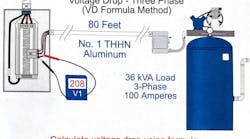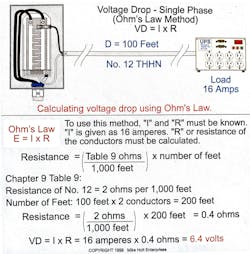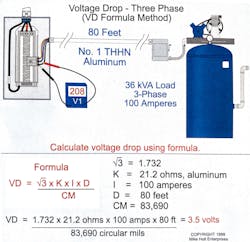Note: This article is based on the 1999 NEC.
Last month, we covered how the NEC addresses voltage drop through a discussion of six Fine Print Notes (FPNs) and several specific rules. This month, we’ll review examples demonstrating how to calculate the voltage drop of conductors using Ohm’s Law or the Voltage Drop (VD) Formula.
Ohm’s Law method: single-phase only
You can determine voltage drop of the circuit conductors by multiplying the current of the circuit by the total resistance of the circuit conductors: VD = I x R. “I” is equal to the load in amperes and “R” is equal to the resistance of the conductor as listed in Chapter 9, Table 8 for direct current circuit, or in Chapter 9, Table 9 for alternating current circuits. Note: You can’t use Ohm’s Law method for 3-phase circuits.
Single-phase, 120V example
What’s the voltage drop of two No. 12 conductors that supply a 16A, 120V load, located 100 ft from the power supply (200 ft of wire)? Refer to Fig 1.
(a) 3.2V
(b) 6.4V
(c) 9.6V
(d) 12.8V
Answer: (b) 6.4V
Voltage Drop = I x R, where “I” is equal to 16A and
“R” is equal to 0.4 ohms [Chapter 9, Table 9: (2 ohm/1000 ft)2200 ft42200 ft]
Therefore, voltage drop = 16A x 0.4 ohms or
Voltage drop = 6.4V, (6.4V/120V = 5.3% volts drop), and
Operating voltage = 120V - 6.4V or
Operating voltage = 113.6V
VD Formula method
If you’ve already installed the circuit conductors, determine the voltage drop of the conductors by using one of the following formulas:
VD = 2 x K x Q x I x D/CM (single-phase) or
VD = 1.732 x K x Q x I x D/CM (3-phase), where “VD” = Volts Dropped: We express the voltage drop of the circuit conductors in volts.
“K” = Direct Current Constant: This is a constant representing the direct current resistance for a 1000 circular mils conductor that’s 1000 ft long, at an operating temperature of 75°C. The direct current constant value you should use for copper is 12.9 ohms and 21.2 ohms for aluminum conductors. The “K” constant is suitable for alternating current circuits, where the conductors do not exceed No. 1/0.
“Q” = Alternating Current Adjustment Factor: You must adjust alternating current circuits No. 2/0 and larger for the effects of self-induction (skin effect). You can find the “Q” adjustment factor by dividing alternating current resistance as listed in Chapter 9, Table 9, by the direct current resistance as listed in Chapter 9, Table 8.
“I” = Amperes: The load in amperes at 100%, not 125% for motors or continuous loads.
“D” = Distance: The distance the load is located from the power supply—not the total length of the circuit conductors.
“CM” = Circular-Mils: The circular mils of the circuit conductor as listed in Chapter 9, Table 8.
Single-phase example
What is the voltage drop for a No. 6 conductor that supplies a 44A, 240V, single-phase load located 160 ft from the panelboard?
(a) 4.25V
(b) 6.9V
(c) 3%
(d) 5%
Answer: (b) 6.9V
VD = 2 x K x I x D/CM, where
K = 12.9 ohms (copper),
I = 44A,
D = 160 ft, and
CM = 26,240 circular mils (Chapter 9, Table 8)
Therefore, VD = 2 wires x 12.9 ohms x 44A x 160 ft/26,240 circular mils, or
V = 46.9V, (6.9V /240V = 2.9% volts drop), and
Operating voltage = 240V - 6.9V or
Operating voltage = 233.1V
Three-phase example
Suppose you have a 3-phase 208V, 36kVA load (100A) located 80 ft from the panelboard wired with No. 1 aluminum conductors. What is the voltage drop of the conductors to the equipment disconnect? See Fig. 2.
(a) 3.5V
(b) 7V
(c) 3%
(d) 5%
Answer: (a) 3.5V
VD = 1.732 x K x I x D/CM, where
K = 21.2 ohms (aluminum),
I = 100A,
D = 80 ft, and
CM = 83,690 circular mils (Chapter 9, Table 8)
Therefore, VD = 1.732 x 21.2 ohms x 100A x 80 ft/83,690 circular mils or
VD = 3.5V (3.5V/208V = 1.7%), and
Operating voltage = 208V - 3.5V or
Operating voltage = 204.5V
Next month, we’ll review how to properly size conductors to accommodate NEC recommendations and its requirements.






